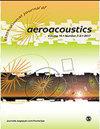Numerical simulation on the acoustic wave scattering and fluid perturbations inside confined orifice flow
IF 1.3
4区 工程技术
Q3 ACOUSTICS
引用次数: 0
Abstract
Acoustic wave scattering and fluid perturbations produced by interactions between incident acoustic wave and confined orifice flow were investigated by a combined numerical solution containing nonlinear flow simulation and linearized acoustic simulation. In flow simulations, the mainstream Reynolds number was fixed at 10,000, which relates to the cooling pipe system of lithography. Turbulent flow fields corresponding to different orifice geometries were solved by an opensource finite volume solver OpenFOAM with Reynolds-averaged Navier–Stokes turbulence model. The turbulence database could efficiently improve the accuracy of subsequent linearized acoustic simulations as the viscosity dissipations were considered. In acoustic simulations, the linearized Navier-Stokes equations were solved by a finite element solver with transformation into frequency domain. The incident acoustic waves with varying frequencies from 500 Hz to 4000 Hz were arranged first at the inlet and then the outlet surfaces, enabling a two-port analysis on the transmission and reflection coefficients of acoustic waves. The numerical setup and the two-port model were well validated by results in literature. Generally, acoustic waves tend to gradually dissipate as their frequencies increase or the opening ratio of the ducted orifice decreases. However, the nonlinear variation in the transmission and reflection coefficients against the frequency variation of the incident acoustic waves could be investigated by increasing the thickness ratio. The acoustically induced fluid perturbations that were characterized by the Q-criterion could form a ring shape vortex structure in the vicinity of the orifice edge and then develop into disk-like packets. When the circumferential shape of the orifice was changed to a square, the attenuation of the incident acoustic waves corresponded to the intensity of the three-dimensionality of the acoustic-induced vortex structures, which indicated a greater energy transfer from the acoustic waves to the fluid perturbations.受限孔板流动中声波散射和流体扰动的数值模拟
采用非线性流动模拟和线性化声学模拟相结合的数值解,研究了入射声波与受限孔板流相互作用产生的声波散射和流体扰动。在流动模拟中,主流雷诺数固定为10000,这与光刻的冷却管系统有关。采用雷诺平均Navier-Stokes湍流模型,通过开源有限体积求解器OpenFOAM求解不同孔几何形状对应的湍流流场。湍流数据库可以有效地提高后续线性化声学模拟的准确性,因为考虑了粘度耗散。在声学模拟中,线性化的Navier-Stokes方程通过有限元求解器进行频域变换求解。频率从500Hz到4000Hz不等的入射声波首先布置在入口表面,然后布置在出口表面,从而能够对声波的传输和反射系数进行双端口分析。数值设置和双端口模型通过文献中的结果得到了很好的验证。通常,声波往往随着其频率的增加或管道孔口的开口率的降低而逐渐消散。然而,透射系数和反射系数相对于入射声波频率变化的非线性变化可以通过增加厚度比来研究。以Q准则为特征的声致流体扰动可以在孔口边缘附近形成环形涡流结构,然后发展成盘状包。当孔的圆周形状变为正方形时,入射声波的衰减与声致涡流结构的三维强度相对应,这表明从声波到流体扰动的能量传递更大。
本文章由计算机程序翻译,如有差异,请以英文原文为准。
求助全文
约1分钟内获得全文
求助全文
来源期刊

International Journal of Aeroacoustics
ACOUSTICS-ENGINEERING, AEROSPACE
CiteScore
2.10
自引率
10.00%
发文量
38
审稿时长
>12 weeks
期刊介绍:
International Journal of Aeroacoustics is a peer-reviewed journal publishing developments in all areas of fundamental and applied aeroacoustics. Fundamental topics include advances in understanding aeroacoustics phenomena; applied topics include all aspects of civil and military aircraft, automobile and high speed train aeroacoustics, and the impact of acoustics on structures. As well as original contributions, state of the art reviews and surveys will be published.
Subtopics include, among others, jet mixing noise; screech tones; broadband shock associated noise and methods for suppression; the near-ground acoustic environment of Short Take-Off and Vertical Landing (STOVL) aircraft; weapons bay aeroacoustics, cavity acoustics, closed-loop feedback control of aeroacoustic phenomena; computational aeroacoustics including high fidelity numerical simulations, and analytical acoustics.
 求助内容:
求助内容: 应助结果提醒方式:
应助结果提醒方式:


